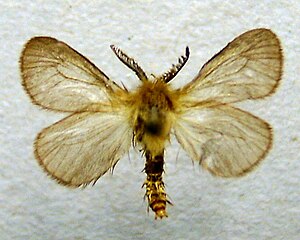Light brown moor sack carrier
| Light brown moor sack carrier | ||||||||||||
|---|---|---|---|---|---|---|---|---|---|---|---|---|

Light brown bog sack carrier ( Megalophanes viciella ) |
||||||||||||
| Systematics | ||||||||||||
|
||||||||||||
| Scientific name | ||||||||||||
| Megalophanes viciella | ||||||||||||
| ( Denis & Schiffermüller , 1775) |
The light brown bog sack carrier ( Megalophanes viciella ), also known as the sweet pea sack carrier , is a butterfly from the family of the real sack carrier (Psychidae).
features
butterfly
The adult animals are characterized by a clear sexual dimorphism . The wings of the males reach a wingspan of about 18 to 22 millimeters, are without drawing, translucent light brown to yellowish brown and have thin hair-like scales. The veins and the darker fringes stand out a little more clearly. The very strongly rounded wings are striking. The antennae of the males are provided with short comb teeth. The body is densely covered with yellow-gray hair. Female animals resemble maggots , are reddish yellow in color, have a cylindrical body, a ring of dense, yellow woolen hair on the abdomen and are about 9 to 11 millimeters long. They have neither developed antennae nor wings and their legs are stunted.
Caterpillar, pupa
The caterpillars vary in color from olive to dark reddish, have a black-brown head and breast shields. You spin yourself into a sack-like living tube. Their inner shape is round. The caterpillar attaches parts of plant stems to the outside so that the silk bag is enveloped in a quiver made of organic substances and resembles that of the caddis flies ( Trichoptera ) living in water . The sack is cylindrical and very evenly covered with short, gray-brown stems that are always transversely arranged. The mean outer diameter is about 7 to 9 millimeters and tapers slightly towards the end. It reaches a length of approx. 17 to 22 millimeters. The male pupa is red-brown in color and has a darker abdomen, while that of the females is black with a red-brown tint at both ends.
Similar species
- The similarly colored male moths of Megalophanes verstinensis can be distinguished by the smaller wingspan, the slightly more elongated wings and the more brownish hair on the body. The sacks are also a bit smaller and slimmer.
Distribution and occurrence
The species is widespread locally in Europe, except in large parts of the northern European landmass, the Mediterranean and the British Isles . Further distribution information can be found in the Middle East and Japan . The animals are mainly to be found in fens and swamp meadows.
Way of life
The male moths fly from June to July. They occasionally visit artificial light sources . The caterpillars have one-year and two-year trunks. During the entire caterpillar stage, the caterpillar remains in its protective cover and also pupates in it. Only the male adult butterfly leaves the caterpillar sac and seeks out the flightless female to mate. The males have an extremely short lifespan of only a few hours, which is also characteristic of other species of the true bag-bearer . Parthenogenetic reproduction also occurs , as has also been observed in breeding. The caterpillars feed polyphagously on many different plants, of which only a selection is mentioned here:
- Sweet peas ( Vicia ),
- Dock ( Rumex ),
- Ledges ( Scirpus ),
- Heather ( Calluna vulgaris ),
- Downy birch ( Betula pubescens ),
- Swamp ziest ( Stachys palustris ),
- Bogberry ( Vaccinium uliginosum )
and other. The larval sac of the animals is attached to grasses, shrubs, shrubs and trunks, with the females predominantly occupying higher positions.
Danger
The species is found in Germany in very different frequencies, but mostly rarely. It is completely absent in some federal states and is classified in category 2 (severely endangered) on the Red List of Endangered Species .
swell
Individual evidence
- ↑ a b c Walter Forster, Theodor A. Wohlfahrt: The butterflies of Central Europe. Volume 3: Weirdos and Swarmers. (Bombyces and Sphinges). Franckh'sche Verlagshandlung, Stuttgart 1960, DNB 456642196 .
- ↑ a b Günter Ebert, Thomas Esche, Rene Herrmann, Axel Hofmann, Hans Georg Lussi, Ingo Nikusch, Wolfgang Speidel, Axel Steiner, Jürgen Thiele: The butterflies of Baden-Württemberg, Volume 3, Moth I (root borer (Hepialidae), wood borer (Cossidae ), Widderchen (Zygaenidae), snail moth (Limacodidae), sack carrier (Psychidae), window stain (Thyrididae)), Ulmer Verlag Stuttgart 1993. ISBN 3-800-13472-1
- ^ A b Arno Bergmann: The large butterflies of Central Germany. Volume 3: Weirdos and Swarmers. Distribution, forms and communities. Urania-Verlag, Jena 1953, DNB 450378365 .
- ↑ Federal Agency for Nature Conservation (Ed.): Red List of Endangered Animals in Germany. Landwirtschaftsverlag, Münster 1998, ISBN 3-89624-110-9
literature
- Günter Ebert, Thomas Esche, Rene Herrmann, Axel Hofmann, Hans Georg Lussi, Ingo Nikusch, Wolfgang Speidel, Axel Steiner, Jürgen Thiele: The Butterflies of Baden-Württemberg, Volume 3, Moths I (root borer (Hepialidae), wood borer (Cossidae), ram (Zygaenidae), snail moth (Limacodidae), sack bearer (Psychidae), window stains (Thyrididae)), Ulmer Verlag Stuttgart 1993. ISBN 3-800-13472-1
- Walter Forster , Theodor A. Wohlfahrt : The butterflies of Central Europe. Volume 3: Weirdos and Swarmers. (Bombyces and Sphinges). Franckh'sche Verlagshandlung, Stuttgart 1960, DNB 456642196 .
- Arno Bergmann: The large butterflies of Central Germany. Volume 3: Weirdos and Swarmers. Distribution, forms and communities. Urania-Verlag, Jena 1953, DNB 450378365 .
Web links
- www.lepiforum.de Photos
- www.schmetterlinge-deutschlands.de Endangerment
- Megalophanes viciella in Fauna Europaea
